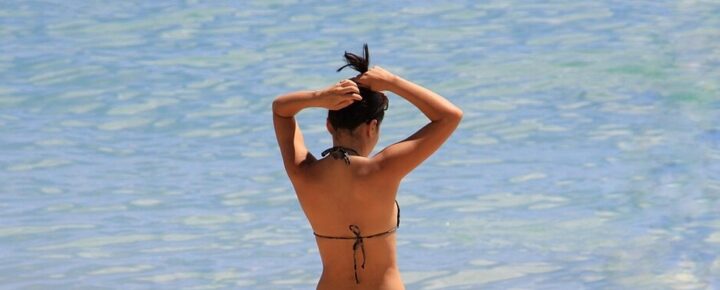You’ve just stepped off the beach, salt still in the air, and head into the local grocery store, still in your swimsuit. Everything feels easy, but something feels a bit off. Are you doing something wrong—or just living your best Hawaii vacation life?
Hawaii has its own set of unspoken rules. No, they’re not written down anywhere—but you’ll feel them the moment you step off the sand.
What’s expected here is about respecting the rhythm of the islands. From the beaches to the neighborhoods, there’s a balance between casual island life and showing the right level of awareness.
Swimwear is everywhere, but there’s also a line. What works for the beach might not be right for the store, the bus, or the local restaurant. The key is understanding the context—and knowing when to step into the island’s unspoken dress code. One word sums it all up: modesty.
Bikini at Safeway? That’s where things shift.
It’s become something of a running theme. Visitors head straight from the beach into Safeway or Longs wearing only a bikini, board shorts, or less. Some residents roll their eyes and move on. Others quietly fume. It will not lead to confrontation, but that doesn’t mean it goes unnoticed.
You won’t find signs at the entrance of most stores saying “No swimwear.” But the expectation is there. Even a simple shirt or cover-up can make the difference between blending in respectfully and standing out for the wrong reasons.
Residents generally understand that the beach is the beach—and everywhere else isn’t. That feeling is especially strong in communities outside the main resort areas, where daily life continues alongside the waves of visitors.
What travelers are asking—and what residents are thinking.
One traveler posted on social media before her Waikiki trip, wondering if revealing dresses and swimsuit cover-ups would be too much. Replies were mixed—some reassured her that Waikiki is laid-back, while others reminded her that modesty still matters in places like restaurants, cultural sites, and Pearl Harbor. “Use your judgment,” one resident said.
The replies were mixed. Some said, “You’ll be fine,” noting that beachwear dominates Waikiki. Others added nuance, pointing out that certain places—restaurants, Pearl Harbor, churches, buses—deserve more coverage. A few mentioned that even if nobody says anything, people do notice.
One person wrote, “To be honest, no one cares anymore, but use your judgment.” Another noted, “You’d be better off buying something nice here than ordering fast fashion that looks out of place.”
These comments don’t come from a place of fashion policing. They reflect a tension between respecting the islands and treating them like a resort. Modesty, in this context, isn’t about shame—it’s about awareness.
Pearl Harbor, small towns, and situational awareness.
There are some places where dressing respectfully isn’t just appreciated—it’s expected. Pearl Harbor is one of those. So are churches, cultural areas, community centers, and smaller towns where beach culture doesn’t define daily life.
That means it’s wise to bring a light dress, T-shirt, or aloha shirt when you plan to go somewhere off the beach path. You won’t be turned away at most places, but you’ll avoid drawing stares—or worse, reinforcing the stereotype that tourists don’t care.
This is especially true on the neighboring islands. While Waikiki has its rhythm and style, places like Hanalei, Wailuku, or Hawi have a different feel. Residents there often dress casually, but you’ll still see a sense of covered, modest comfort that visitors would do well to mirror.
Modesty doesn’t just apply to the beach or store; it extends to the skies, too. Airlines flying to Hawaii have increasingly addressed how passengers dress before boarding—something that’s often overlooked in the vacation rush. Airlines reserve the right to deny boarding to those in overly revealing clothing or barefoot, reinforcing that what works on the beach doesn’t always translate elsewhere.
Airlines weigh in.
As we covered in our article Barefoot, Beachwear, and Banned, airlines flying to Hawaii have increasingly responded to travelers boarding in little more than swimwear and slippers.
Airlines have dress codes, though they’re rarely enforced unless things go too far. Most carriers reserve the right to deny boarding to passengers wearing clothing that’s overly revealing, offensive, or going barefoot.
The underlying issue is similar: what works on the beach doesn’t always translate elsewhere—even on a flight full of Hawaii-bound travelers.
What to wear instead: simple shifts make a big difference.
No one’s saying visitors should pack formal clothes or abandon comfort. But thoughtful choices help bridge the cultural gap. Here are a few tips that reflect what residents tend to appreciate—and what can help travelers avoid the quiet judgment that sometimes comes their way.
Thoughtful choices can go a long way. Throwing on a shirt or light dress before heading into stores or restaurants helps. Wearing sandals rather than walking barefoot into shops is appreciated. A pareo or cover-up works well when exploring outside resort zones. For men, a T-shirt and shorts are simple but respectful.
These aren’t rules. There’s no dress code printed on your boarding pass or hotel key. But small gestures like these signal that you get it—that you’re here not just to visit but to respect the place and people while you’re here.
One word says it all.
If you remember only one thing about what to wear in Hawaii, make it this: modesty.
It’s the quiet guideline that shapes what works here. It reflects a deeper cultural truth, one that goes beyond fashion. Visitors are welcome and appreciated—but how you present yourself speaks volumes.
Modesty doesn’t mean changing who you are. It means understanding where you are.
So next time you’re packing for Hawaii, remember: modesty isn’t just a guideline—it’s a way to show respect for the islands and their people.
We welcome your comments. Mahalo!
Get Breaking Hawaii Travel News







Those who choose to board a plane in swimsuit, etc. will “enjoy” the flight freezing to death. (And the same for very open sandals!) Just sayin’.
I love this article. I miss the modesty everywhere, including airlines. and believe me I used to be , yes used to be, a hottie. But I never ever flaunted and knew to be proper one step off the beach. People are not raising their children to be respectful and classy anymore. It is clear, sad, and you think littering the beach is bad, littering the streets and stores with poor clothing judgment is just as bad. Wear your teeny tinys on the beach, then use a nice coverup off. Period
This issue is symptomatic of the entitlement so prevalent today. I don’t want to make too much of it, but among some visitors from the mainland, there is an assumption that because they’ve paid a lot of money, they’re entitled to do whatever they want. These select few pay absolutely no attention to local customs or traditions.
Whenever I go to Safeway to grab something for lunch, I see an endless parade of pale white or sunburned skin in swimwear, sometimes barefoot. It’s not a good look by itself, and even less so in inappropriate surroundings.
A lot of people never know and I was informed that Hawaii is really close to the equator. In this event you sunburn and get heat stroke very easily and fast. Being light skinned I had my family bring swimming shorts and changed in a local beach restroom. I also prefer to wear pants to the knees with pockets to carry change and a wallet if going into a store. On Oahu the bus wouldn’t let people on if someone only wore a swimsuit. I myself feels like wearing a swimsuit in a place of business is real tacky.
Modesty … Good Advice
Best BOH article I’ve read! 👏
Probably most people who read this already know this, though. Wish we could hand out an excerpt to arriving tourists.
2 problems…
1. It was mentioned that people should use their “judgment” when deciding what to wear… a lot of people don’t have any. They are clueless and have no self awareness.
2. Modesty… people confuse that with being “moral”. It has everything to do with respect for yourself and others around you.
Just my $.02
the problem with – “use your judgement” – is, people think it’s their right to do exactly as They please, not what society hopes for. in other words, there is too much ‘poor’ judgement. Does modesty still exist?
another example – stealing a better seat on the plane – they have no right to it, but try it anyway. and other disturbances on planes that cause inconvenience to others – but they feel they can do what They are entitled to do.
Your words about proper attire are spot on, however there has been a slow shift over the years and I’m not quite sure what the cause of it is, other than selfishness or lack of thought or both.
We have been travelling to the islands for three decades and witnessed exactly the subject of your article, but it seems it only has become more prevalent in the last ten years. It’s usually visitors to the islands that have disregard to this courtesy.
It’s a two-edged-sword however, for the merchants don’t want to discourage patrons by posting signs to that effect with possible loss of sales the result.
Visitors should simply remember that you would not act that way in their hometown so act the same when you’re in Hawaii.
Excellent!
This is a valuable piece of information! Modesty is a form of respect for others and yes, yourself…even on vacation. Thank you for sharing!